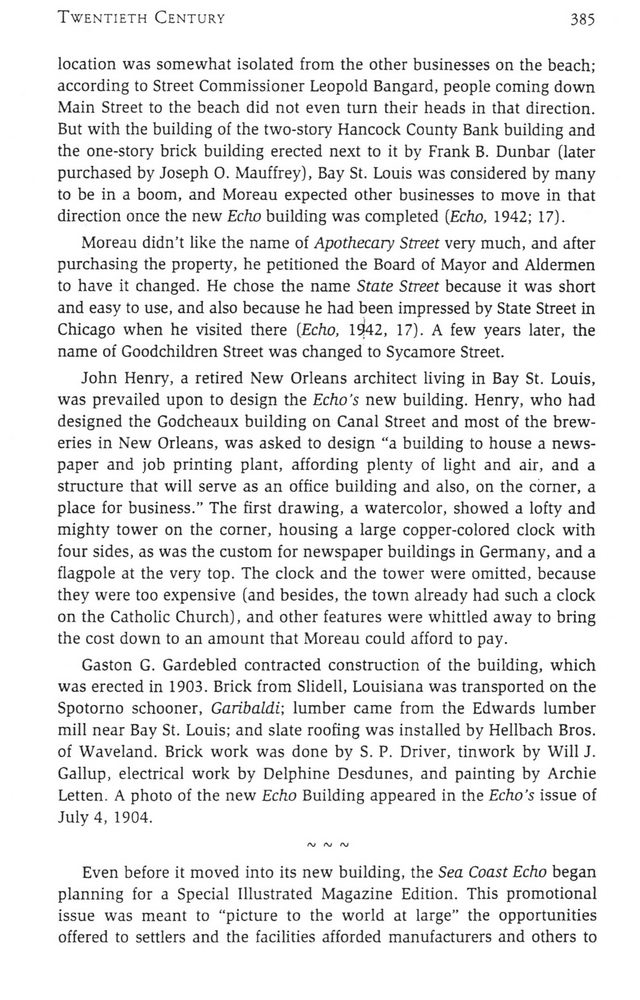This text was obtained via automated optical character recognition.
It has not been edited and may therefore contain several errors.
Twentieth Century
385
location was somewhat isolated from the other businesses on the beach; according to Street Commissioner Leopold Bangard, people coming down Main Street to the beach did not even turn their heads in that direction. But with the building of the two-story Hancock County Bank building and the one-story brick building erected next to it by Frank B. Dunbar (later purchased by Joseph O. Mauffrey), Bay St. Louis was considered by many to be in a boom, and Moreau expected other businesses to move in that direction once the new Echo building was completed {Echo, 1942; 17).
Moreau didn?t like the name of Apothecary Street very much, and after purchasing the property, he petitioned the Board of Mayor and Aldermen to have it changed. He chose the name State Street because it was short and easy to use, and also because he had been impressed by State Street in Chicago when he visited there {Echo, 1SI42, 17). A few years later, the name of Goodchildren Street was changed to Sycamore Street.
John Henry, a retired New Orleans architect living in Bay St. Louis, was prevailed upon to design the Echo's new building. Henry, who had designed the Godcheaux building on Canal Street and most of the breweries in New Orleans, was asked to design ?a building to house a newspaper and job printing plant, affording plenty of light and air, and a structure that will serve as an office building and also, on the corner, a place for business.? The first drawing, a watercolor, showed a lofty and mighty tower on the corner, housing a large copper-colored clock with four sides, as was the custom for newspaper buildings in Germany, and a flagpole at the very top. The clock and the tower were omitted, because they were too expensive (and besides, the town already had such a clock on the Catholic Church), and other features were whittled away to bring the cost down to an amount that Moreau could afford to pay.
Gaston G. Gardebled contracted construction of the building, which was erected in 1903. Brick from Slidell, Louisiana was transported on the Spotorno schooner, Garibaldi; lumber came from the Edwards lumber mill near Bay St. Louis; and slate roofing was installed by Hellbach Bros, of Waveland. Brick work was done by S. P. Driver, tinwork by Will J. Gallup, electrical work by Delphine Desdunes, and painting by Archie Letten. A photo of the new Echo Building appeared in the Echo?s issue of July 4, 1904.
t\j i\j
Even before it moved into its new building, the Sea Coast Echo began planning for a Special Illustrated Magazine Edition. This promotional issue was meant to "picture to the world at large? the opportunities offered to settlers and the facilities afforded manufacturers and others to

Gardebled Louisiana's-Loss-Mississippi's-Gain-page-385